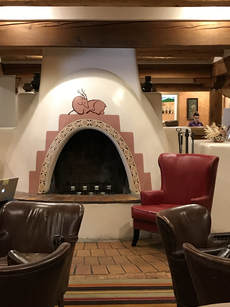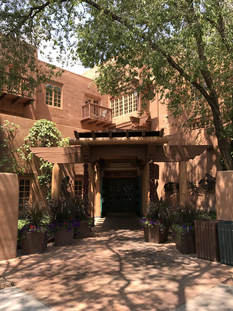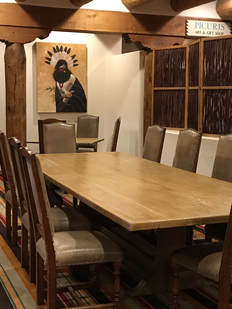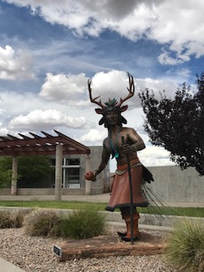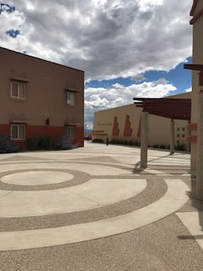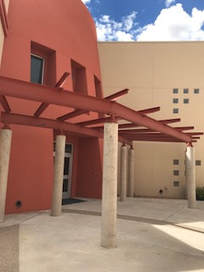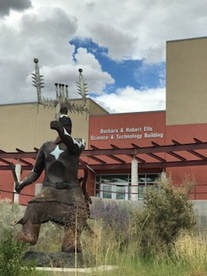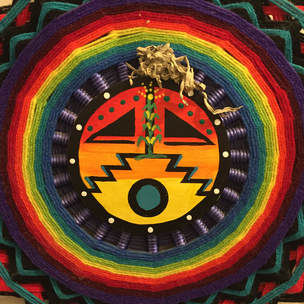International Contact:
Mark Buell, Internet Society
Regional Contact:
Jennifer Nevarez, Internet Society New Mexico Chapter
[email protected]
505-699-1503
What is the state of indigenous connectivity today?...
What do we want to do about it?...
Indigenous Connectivity Summit
November 8-9, 2017
Santa Fe, New Mexico
On November 8-9, join us to identify ways to tackle challenges and celebrate opportunities related to connecting Indigenous communities in North America, including community networks, cultural preservation, and more.
Hear from community network managers/operators, Indigenous-owned Internet service providers, community members, researchers, policy makers and Indigenous leadership.
The Indigenous Connectivity Summit is an initiative of the Internet Society,
the Internet Society New Mexico Chapter, Community Learning Network ~ New Mexico TechWorks, the 1st-Mile Institute, and the First Mile Connectivity Consortium.
Who Should Participate?
The Indigenous Connectivity Summit will gather community network managers/operators, Indigenous-owned Internet service providers, community members, youth, students, researchers, policy makers, and Indigenous leadership to join the conversation. We’ll discuss ways to ensure Alaska Native, Native American, Inuit, First Nations, and Métis communities have affordable, high-quality and sustainable Internet access, and how it can support social, cultural, and economic vitality.
Where?
Santa Fe
Santa Fe, New Mexico, is known worldwide for its beauty and as a hub for the arts and culture, as well as science.
The region is home to 23 tribes, including 19 pueblos, three Apache tribes, and the Dine Nation (the Navajo),
which are separate sovereign nations within the borders of the United States.
In addition to Spanish, there are 8 native languages spoken in the region
including Tiwa, Tewa, Towa, Keres, Zuni, Dine’ (Navajo), and two dialects of Apache.
and over 219,000 Native American citizens, which represents nearly 10.5% of the population of the state.
Plus, more than 47% of the population is Hispanic,
and as the Pew report notes, a language other than English is spoken in more than 61% of homes in New Mexico.
Limited internet access and poor connectivity, plus issues of affordability and relevancy,
have been challenges in the mountainous, desert, and highly rural regions of New Mexico
where income levels and density are generally low.
The region is home to 23 tribes, including 19 pueblos, three Apache tribes, and the Dine Nation (the Navajo),
which are separate sovereign nations within the borders of the United States.
In addition to Spanish, there are 8 native languages spoken in the region
including Tiwa, Tewa, Towa, Keres, Zuni, Dine’ (Navajo), and two dialects of Apache.
and over 219,000 Native American citizens, which represents nearly 10.5% of the population of the state.
Plus, more than 47% of the population is Hispanic,
and as the Pew report notes, a language other than English is spoken in more than 61% of homes in New Mexico.
Limited internet access and poor connectivity, plus issues of affordability and relevancy,
have been challenges in the mountainous, desert, and highly rural regions of New Mexico
where income levels and density are generally low.
Hotel Santa Fe Hacienda and Spa
1501 Paseo de Peralta Santa Fe, New Mexico 87501 www.hotelsantafe.com Reservations: 1 (855) 825-9876
PreConference Events @ the Institute of American Indian Arts
Monday, November 6, 2017, 2-6pm
Student Open House and Dedication of the New Performing Arts Building
Interested in joining us? |
It is FREE!
When: Wednesday and Thursday, November 8 and 9, 2017 Where: Hotel Santa Fe Hacienda and Spa , the only Native-owned hotel in Santa Fe. Book your hotel room now. For more information, please contact [email protected]. |
PLUS: Two-day Community Networking Training Session - November 6 and 7
Attendees who are currently operating a community network, planning to deploy one, or curious about networks also have the option to participate in a two-day training session November 6th and 7th.
Community networks are usually built and operated by citizens who want to connect their village, city, or town to the Internet. Participants do not need prior knowledge of community networks to participate. To see indigenous community network success stories, please read
“By Indigenous Communities, for Indigenous Communities”.
If you would like to change your summit registration to include the two-day training session, please contact Nicole Carolin at [email protected].
Attendees who are currently operating a community network, planning to deploy one, or curious about networks also have the option to participate in a two-day training session November 6th and 7th.
Community networks are usually built and operated by citizens who want to connect their village, city, or town to the Internet. Participants do not need prior knowledge of community networks to participate. To see indigenous community network success stories, please read
“By Indigenous Communities, for Indigenous Communities”.
If you would like to change your summit registration to include the two-day training session, please contact Nicole Carolin at [email protected].
LEARN, SHARE, EXPLORE...
Real-life stories of Connectivity from around the world...
|
Meet some amazing people doing amazing things...
Speakers and panelists include:
Kahif Ali, Facebook
Elizabeth Belding, UC Santa Barbara
Geoffrey Blackwell, AMERIND Risk
Peter Bloom, Rhizomatica
Sally Braun, Western James Bay Telecommunications Network
Sandy Campbell, Digital Library North
Penny Carpenter, KNET
Kit Carson Electric Coop
Lyle Fabian, Katlotech Communications
Eric Huerta, Redes Comunica
Richard Jimmerson, ARIN
Adrienne Keene, Native Appropriations
Claudia Lezama, La Loma Projects
Bill Murdoch, Manitoba First Nations Education Resource Centre
Nico Pace, Alter Mundi
Matthew Rantanen, Southern California Tribal Chairmen's Association
Madeline Redfern, City of Iqaluit
Steve Song, Village Telco Limited
Brian Tagaban, Sacred Wind Communications
Lope Trujillo, La Loma Projects
Jeff Ward, Animikii
Time Whiteduck, First Nations Education Council
Kathy Brown, President of ISOC, ISOC
Susan O’Donnell (Canada), First Mile Connectivity Consortium
Vanessa Roanhorse, Cultivating Coders
Jennifer Nevarez (US), Community Learning Network and New Mexico TechWorks
Jane Coffin (US), Internet Society
Mark Buell (Canada), Internet Society, North American Deputy Chief
Merridith Ingram (US), Silicon 66
Richard Lowenberg (US), 1st Mile Institute of New Mexico
Paige Prescott (US), Computer Science Teachers Association of New Mexico and Code.org facilitator
Elizabeth Belding, UC Santa Barbara
Geoffrey Blackwell, AMERIND Risk
Peter Bloom, Rhizomatica
Sally Braun, Western James Bay Telecommunications Network
Sandy Campbell, Digital Library North
Penny Carpenter, KNET
Kit Carson Electric Coop
Lyle Fabian, Katlotech Communications
Eric Huerta, Redes Comunica
Richard Jimmerson, ARIN
Adrienne Keene, Native Appropriations
Claudia Lezama, La Loma Projects
Bill Murdoch, Manitoba First Nations Education Resource Centre
Nico Pace, Alter Mundi
Matthew Rantanen, Southern California Tribal Chairmen's Association
Madeline Redfern, City of Iqaluit
Steve Song, Village Telco Limited
Brian Tagaban, Sacred Wind Communications
Lope Trujillo, La Loma Projects
Jeff Ward, Animikii
Time Whiteduck, First Nations Education Council
Kathy Brown, President of ISOC, ISOC
Susan O’Donnell (Canada), First Mile Connectivity Consortium
Vanessa Roanhorse, Cultivating Coders
Jennifer Nevarez (US), Community Learning Network and New Mexico TechWorks
Jane Coffin (US), Internet Society
Mark Buell (Canada), Internet Society, North American Deputy Chief
Merridith Ingram (US), Silicon 66
Richard Lowenberg (US), 1st Mile Institute of New Mexico
Paige Prescott (US), Computer Science Teachers Association of New Mexico and Code.org facilitator
Watch stories about some amazing projects...
Byron Nocholai (Alaska), I sing, you dance
Chad Henry (Ojibway), Ochiichagwe'Babigo'Ining Ojibway Nation
National Inuit Youth Council
Vint Cerf, Google
New Mexico Indigenous Language Institute
Community Networking - “By Indigenous Communities, for Indigenous Communities”.
and more...
Chad Henry (Ojibway), Ochiichagwe'Babigo'Ining Ojibway Nation
National Inuit Youth Council
Vint Cerf, Google
New Mexico Indigenous Language Institute
Community Networking - “By Indigenous Communities, for Indigenous Communities”.
and more...
Check out additional
Connectivity Summits
Indigenous Connectivity Summit 2018 (ICS)
Wednesday - Thursday, October 11-12, 2018
Inuvik, Northwest Territories, Canada.
ICS 2018 is an initiative of the Internet Society, in partnership with the Inuvialuit Regional Corporation, the Town of Inuvik, the University of Alberta, and the First Mile Connectivity Consortium. This community-led forum at the Midnight Sun Complex in Inuvik, Northwest Territories, Canada, will focus on middle mile and backhaul for very rural or remote Indigenous communities in Canada and the United States with a series of panels, presentations, workshops, and networking events. Some of the world’s leading thinkers on Internet connectivity will be in attendance, including business and community leaders, network operators, representatives from the Canadian and American governments, among others. By participating in this event, you will play an important role in helping us find ways to ensure Inuit, First Nations, Métis, Alaska Native, and Native American communities explore the ways and means to enable affordable, high-quality and sustainable network access, with ways to support social, cultural and economic development. Watch the Indigenous Connectivity Summit 2018 Livesream here
OR read the Indigenous Connectivity Summit 2018 Report here.
Watch More information is also available on the Summit Website.
Wednesday - Thursday, October 11-12, 2018
Inuvik, Northwest Territories, Canada.
ICS 2018 is an initiative of the Internet Society, in partnership with the Inuvialuit Regional Corporation, the Town of Inuvik, the University of Alberta, and the First Mile Connectivity Consortium. This community-led forum at the Midnight Sun Complex in Inuvik, Northwest Territories, Canada, will focus on middle mile and backhaul for very rural or remote Indigenous communities in Canada and the United States with a series of panels, presentations, workshops, and networking events. Some of the world’s leading thinkers on Internet connectivity will be in attendance, including business and community leaders, network operators, representatives from the Canadian and American governments, among others. By participating in this event, you will play an important role in helping us find ways to ensure Inuit, First Nations, Métis, Alaska Native, and Native American communities explore the ways and means to enable affordable, high-quality and sustainable network access, with ways to support social, cultural and economic development. Watch the Indigenous Connectivity Summit 2018 Livesream here
OR read the Indigenous Connectivity Summit 2018 Report here.
Watch More information is also available on the Summit Website.
Indigenous Connectivity Summit 2019 (ICS)
The Indigenous Connectivity Summit 2019, held in Hilo, Hawai’i, on November 12-13, focused on building partnerships, advocating regulatory changes, and sharing success stories of community networks throughout Canada and the United States.
If you weren’t able to join us, watch the Indigenous Connectivity Summit 2019 online here
OR read the Indigenous Connectivity Summit 2019 Report here.
If you weren’t able to join us, watch the Indigenous Connectivity Summit 2019 online here
OR read the Indigenous Connectivity Summit 2019 Report here.
